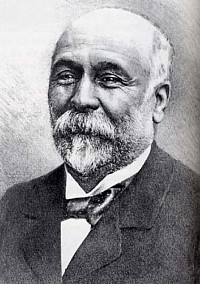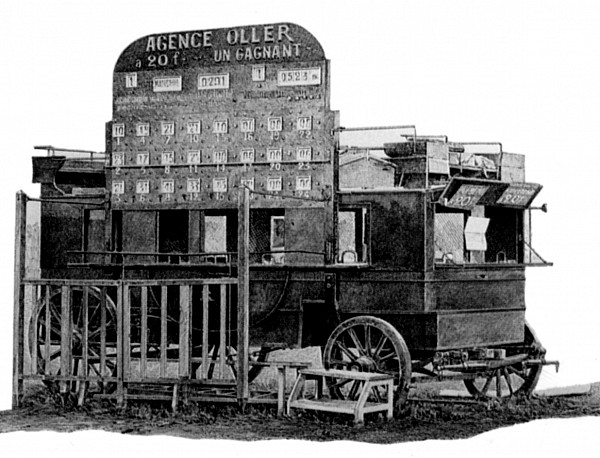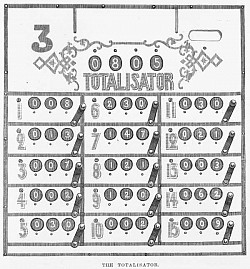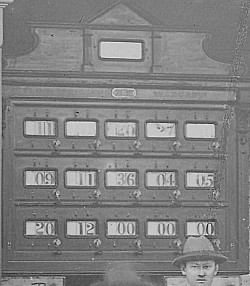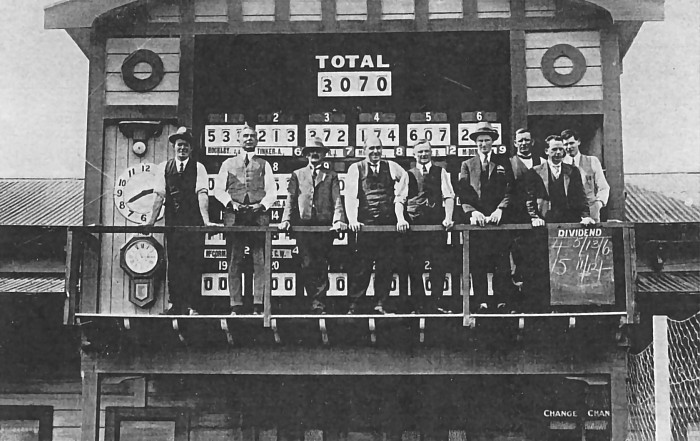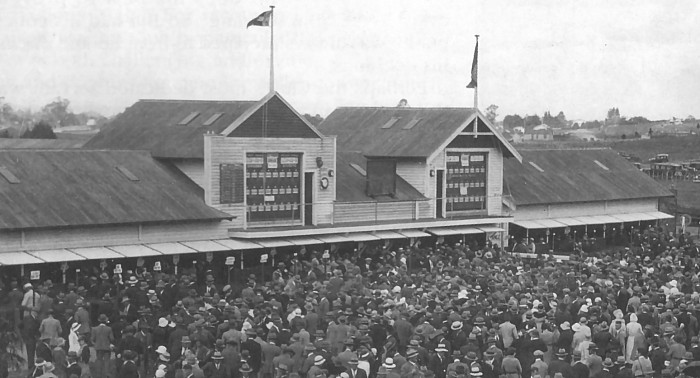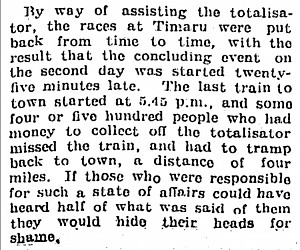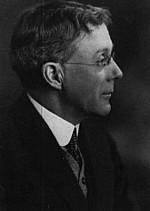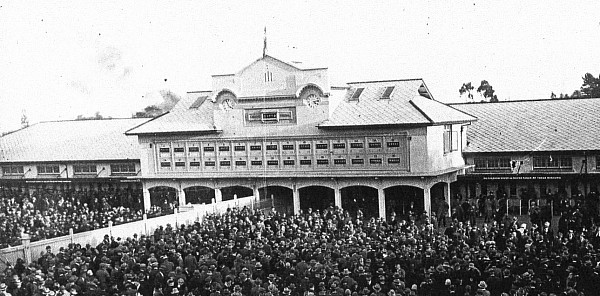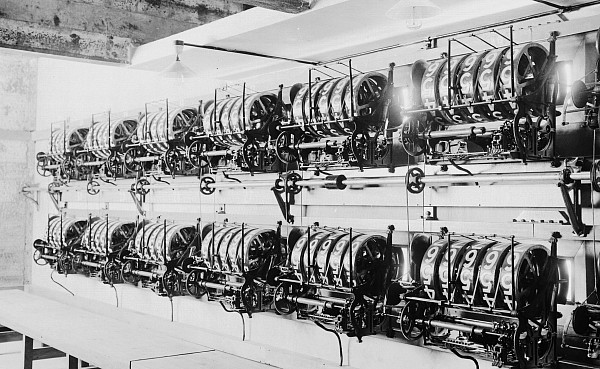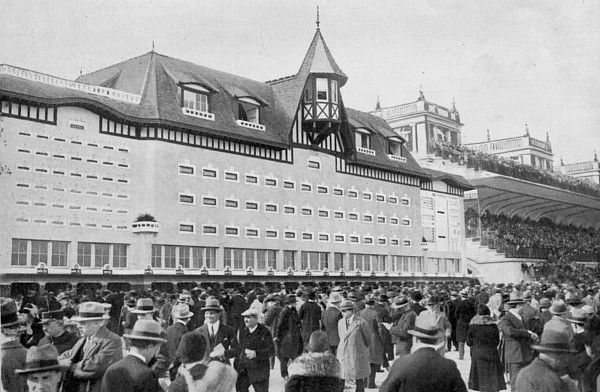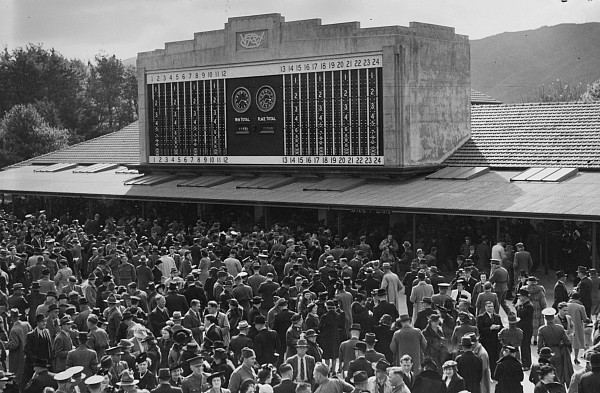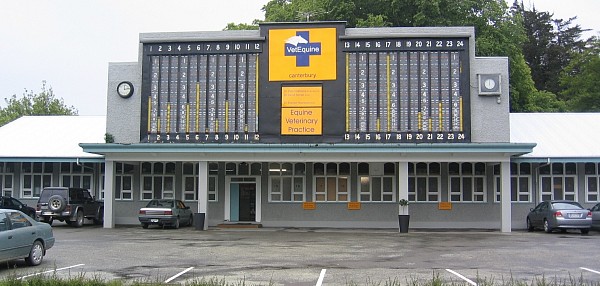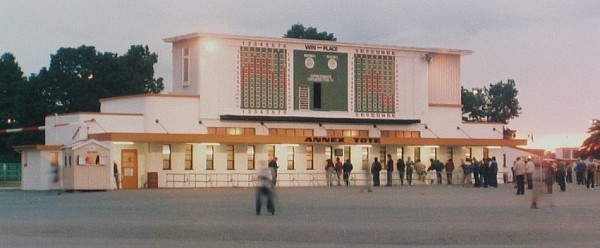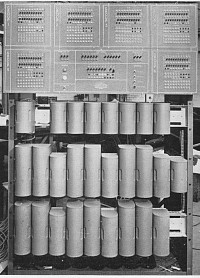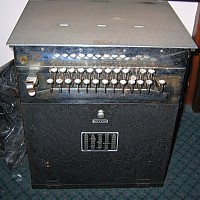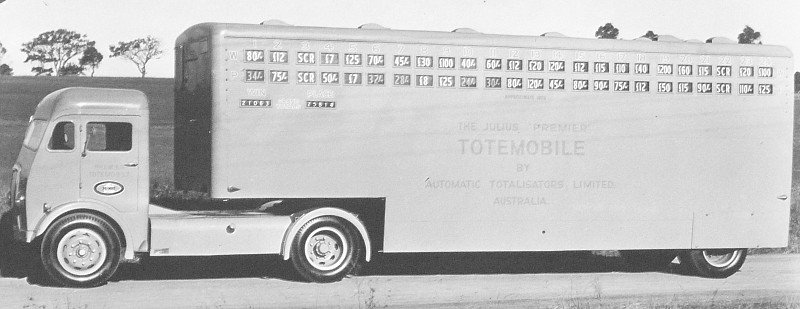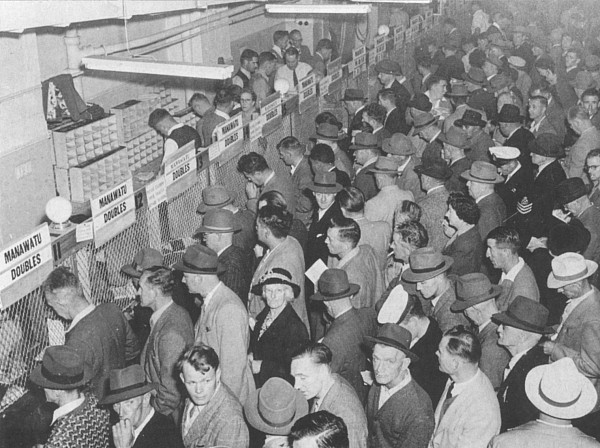Computer Science
Totalisators: New Zealand History
This is a brief summary of the history of the totalisator, mainly confined to New Zealand, intended to provide context for the other material we have in these pages. Some of this is based on an earlier summary at www.rutherfordjournal.org/article020109.html.
The totalisator was conceived in the 1860s by Joseph Oller, a resident of Paris, of Catalan origin. He was sent to Bilbao by his father to learn Spanish and while there observed cock fighting and the bickering that occurred among the gamblers. This inspired him to propose a gambling system, which became known as pari-mutuel (wagering among ourselves), where the amounts bet on all of the individual horses were totaled, reduced by a commission or fee, and distributed to the winners in proportion to the amount of each bet. Pari-mutuel gambling is an attractive alternative to fix-odds betting with a bookmaker – the gambler need have no concern that poor odds are being offered, or feel the need to “shop around” for the best deal. However, the big disadvantage of pari-mutuel compared to the bookmaker’s fixed odds is that the gambler has no understanding of the return to expect from a bet. Oller overcame this defect by displaying, as the betting was taking place, the number of bets made on each horse and the grand total of all bets made for the race. Although not as simple as “paying 2 for 1” the gambler can easily get a “feel” for the magnitude of expected returns.
Oller started pari-mutuel beting in Paris in 1867. Gambling was performed at race tracks from large wagons that were driven to the courses in the suburbs. Later there was off-course gambling from offices in the city. This enterprise was very successful, making Oller both wealthy and famous.
Before pari-mutuel was invented there was much use made of what we would call today "office pool" gambling where tickets were sold with numbers and later each assigned at random to a horse. This was clearly gambling which was illegal in France at the time. It was thought that pari-mutuel might be immune from this restriction because the bettor had to use skill in selecting the horse to back. However, when this was finally put to the test pari-mutuel was banned in France from 1875.
Although this was a major set-back for Oller he continued to thrive as an entertainment entrepeneur and impresario. He opened a number of entertainment centres in Paris, most notably the Folies Bergères. In 1887 pari-mutuel returned to France and Oller played a major part in its management. His businesses continued to thrive and he became one of the most significant figures of fin-de-siecle Paris. (Oller's life is covered in the biography “L’Homme de la belle époque” by Ferran Canymeres, Les Editions Universelles, Paris, 1946. This is available only in French but a summary of the book as it applies to pari-mutuel is here.)
When the pari-mutuel returned to Paris in 1886 the locals were surprised to find that it was now called the "totalisator." The origin of this name is unknown, probably from outside France, although it seems to have been derived from the French totalisateur for counter. The use of the totalisator was widespread by this time - the first record found so far of the totalisator outside France was Hamburg in 1871 (the term wettmaschine is sometimes used in German) - and by 1886 it was in use in Germany, Austria, Italy and had also spread to the southern hemisphere.
It would be a very large task to summarise the history of the totalisator globally. The course of affairs was different in each country. In many countries, as in France, it was soon banned. In others, also like France, it was banned for a period. Pressure for banning came from a strange alliance of those opposed to any gambling and bookmakers who wanted to protect their trade. This meant that many countries were slow in adopting the totalisator, not until 1928 in the UK, 1930s in the USA and the Australian State of Victoria.
In Australia and New Zealand the totalisator began to be a topic of conversation in 1878 but in coming to the antipodes the totalisator had somehow been turned into a machine! The first discussion of the concept in the Sydney newspapers involved the German consul Siegfried Franck who began to advertise totalisator machines for sale. These first machines were small and maintained total numbers of bets for each horse together with a grand total. Franck was not successful in having totalisators adopted in Sydney but the news had spread across the Tasman and the totalisator was eagerly anticipated in New Zealand. It was first introduced at Ashburton for the Spring race meeting on Wednesday 19th November 1879 as described in the Christchurch Press on November 20th:
The totalisator was on the ground, for the first time in New Zealand. Messrs Lee, Lee, Murray and Co. were its possessors, and were well patronized. They argue that they give better odds than the bookmakers. Those backing the winner receive a share of the total amount deposited, 10 per cent being deducted, and if the winner is not backed depositors receive their money back less 10 per cent. About 2.00 pm. the rain came down heavily and many ladies left the course, but the love of sport kept the sterner sex on the ground to a man.
By the end of the 1979-80 summer the totalisator seems to have spread throughout the country - there are newspaper reports from Wellington, Auckland, and North Canterbury. Here is a report in the Christchurch Press, February 6th, 1880, on the introduction of the totalisator at Trentham:
Two totalisators were conaplonious (sic) in the paddock. People were very shy at first, but they soon began to understand the principle and patronized them freely. The odds are a good 50 per cent larger than was offered by bookmakers. Only one list man did business outside, and he gave it up as a bad job. The machine has effected a wonderful revolution in this respect, and it is generally admitted to be a great improvement on the yelling and confusion caused by the list men. About £750 were put through during the day. The machine also affected bookmakers, who did far less business than usual.
The accounts seem to imply that machines are being used though that is not certain - we know that pari-mutuel commenced without machines and there is one account of a totalisator being run on a blackboard at a NZ country race meeting and another of a barber being prosecuted for running a totalisator out of his shop. But there must have been a lot of machines involved. It is likely that many were imported but there was also immediate interest in building them locally. An account of what is known of these early machines is here.
In New Zealand the authorities turned a blind eye to the totalisator initially and it was never banned as a form of gambling. This is in contrast with Australia where the bookmakers were much more powerful - by autumn 1880 Mr Franck had moved on to New Zealand, selling his machines and maintaining that he owned patent rights. But the tote craze seemed unstoppable and it was run without impediment for a few years. However, the way that races were beginning to be held anywhere in order to operate a totalisator caused some legislative action. From 1881 the machine was restricted to licensed race courses. Because of the proliferation of small racing clubs intended to gather private profit from the totalisator, in 1895 totes were restricted to being operated by genuine racing clubs on a limited number of days each year. The monopoly over on-course tote operation put the clubs in a very powerful position. The small machines continued to be operated at country venues but all of the larger clubs soon replaced them with a different mode of operation of higher capacity, what we will call "the manual totalisator".
It may seem strange to single out manual totalisators as a new development given that totalisators had been operated manually from the time of Oller. However, the approach taken to the totalisator by racing clubs, once they were given the monopoly of its operation, was quite different from what came before. The crowds at the major race courses were large and the capacity of the old totalisator machines was small. The prospect of managing large numbers of small machines and ensuring their integrity was not attractive: Under the old system with eleven machines going at once, there was litle breathing time .... (from 1908 article about Harry Hayr.) What was a much more desirable goal was managing just one totalisator for the whole race course. With thought and careful planning this turned out to be quite practical and successful as seen in this very-early image of the totalisator at Trentham:
The aim was to centralise sales of tickets so that tallies could be kept of total bets on each horse as betting took place. The sales from each ticket seller were, on a regular cycle, themselves added together to give course-wide sales for each horse and a grand total for all horses. These totals were put-up on large displays that were visible to the whole crowd. All the work was done manually - skill with arithmetic was common in these pre-calculator days. The displays looked professional but were only means of showing numbers so that they could be changed quickly by hand (there were counting devices used in some situations but these were not necessary.)
Because of the need to control what was happening and have unrestricted flow of data, as well as the need to display totals in large figures at a height where they could be read from a distance, racing clubs built special buildings in which to operate their totalisators. It is not too far-fetched to regard these buildings, when in operation, as being computers themselves, although very special purpose. Like computers, they followed algorithms, they had inputs and outputs, performed calculations and displayed results on a screen. Of course, they operated on manpower (working in a totalisator was not considered to be suitable work for a woman, at the time) rather than electricity but from the user's viewpoint how they worked internally was irrelevant. Indeed, they were commonly called "the totalisator machine" whether or not any machinery was involved. Here are some of the operators of a totalisator (as yet unknown location) posing after a hard day at the office:
We do not know when the first course-wide totalisator was set operating. The movement started with the larger courses first, there are pictures of the totalisator at Riccarton in Christchurch dating from 1902. The course-wide totalisators spread gradually throughout the country so that, judging from what buildings remain, they were used on all but the smallest tracks by the 1920s. Presumably, the same developments took place in other countries where the racing clubs with their totalisators had the on-course gambling rights - certainly in France.
The large race courses had large impressive totalisator buildings and those of the smaller tracks were more modest. There were practical difficulties in operating a large totalisator well - it required very good management. Once suitable machines were available they replaced the fully manual operation, often being housed in new buildings. At most of the larger courses automatic machines were installed before 1930, but the smaller manual totalisators continued to be operated through the 1950s. These were later mechanised using portable equipment but the buildings were in many cases retained. More details on the manual totalisator machines are here.
Having an official organization supervise the totalisator gave it confidence in the eyes of the gambling public but it also increased the size of the crowds attending the race courses. It is hard nowadays to comprehend how important racing was when there were few others outlets for entertainment, particularly before off-course betting was allowed. Even in a small city like Auckland race crowds in excess of 40,000 were recorded. There were larger crowds in larger cities, over 70,000 in New York, over 100,000 in Buenos Aires.
A well-managed manual totalisator should be able to handle large crowds. However, they did not always perform reliably. Totalisators were subject to regulation. One common rule was that, to avoid fraud, the totalisator had to be closed, with all bets registered, before a race could start (the totalisator being ready was often signaled to the distant race starter by raising a balloon.) Perhaps because of the practical difficulties of managing the process as it became larger the totalisator caused unacceptable delays to racing. An example of the unfortunate result is in this newspaper article (from NZ Truth, 3 May 1913, via "Papers Past").
There was a great need for some secure method of providing timely totals in the face of many thousands of gamblers. Happily, with bookies banned from 1910 and clubs having a monopoly on (legal) gambling, the racing clubs had the funds to cover costs of automation. This started in 1913 with the first mechanical totalisator at Ellerslie. The first machine was rather special - it is described in some detail here.
The Ellerslie totalisator was the brain child of George (later Sir George) Julius. He was English by birth but brought up in Ballarat in Australia and later in Christchurch, NZ, where his father was the Anglican bishop. George graduated from Canterbury College of the University of New Zealand (later University of Canterbury) in 1896 with a BSc in Mechanical Engineering. His career was as a professional engineer in Australia, eventually operating out of Sydney. He is said to have designed a voting machine but could not find customers so applied his concepts to totalisators at race courses where elections are more frequent. Julius founded the company Automatic Totalisators Ltd (ATL) of Sydney which designed and installed the mechanical totalisator at Ellerslie, the first of a long line of machines produced by the company.
Note that an automatic totalisator did not completely automate all work - as stated in the "Noble Breed" by William Mackie
The machine did not reduce the staff required to operate the totalisator, in fact the reverse was the case, but it did enable the betting transactions to be recorded accurately, to show immediately the investments being made on the various horses, and the machine could now be balanced in two minutes instead of the 10 minutes or more required under the former manual system.
After the first world war there was a rash of installations of automatic totalisators, initially at Australia and New Zealand sites but then spreading world-wide. For a decade ATL had the field to themselves, and by the end of 1922, the Ellerslie machine had been replaced and there were installations at Trentham, Riccarton, Wanganui, Feilding and Palmerston North. With these new machines ATL fixed the shortcomings of the first machine by using ticket issuing and printing machines, electrical connections and electric motor drive. However, the external appearance was a display of bet totals just as in the first machine and the manual totalisators, for example, the new machine at Ellerslie:
The inner workings for these machines were also much simplified and orderly as in the machine at Trentham:
In his only published paper "Mechanical Aids to Calculation" in 1920 George Julius discussed the goal of recording 1 million unit bets in the 1/2 hour before each race. Its not clear that this was ever attained but in 1928 he came close with what was the pinnacle of this early development at Longchamp in Paris. There was a stupendous amount of machinery involved, including 273 ticket machines. Dubbed "The Insatiable Moloch" by the local press, this was kept operating until 1973. The machine building is still in place though its machinery is long-gone.
The Julius machines became so reliable that they could be depended on for accurate totals of bets. Each ticket machine recorded the total number of tickets sold, so there was a cross-check possible against total bets recorded, but the machine was relied on for totals of individual horses. However, at the end of each race betting there were adjustments to be made that had to be performed by hand (or using a calculator,) for example dealing with tickets that were issued for the wrong horse - the totalisator machinery could add but not subtract!
A second round of machinery was installed in the 1930s that disposed of the large counters and, instead, displayed expected dividends using a large "barometer" display. In most cases, at the same time, the machines were extended to also predict dividends for place bets (in NZ, this means 1st, 2nd or 3rd unless the field of horses is small.) In some cases the new machines were placed in new buildings and, in others, such as Ellerslie, the building was extended forwards to house the displays and just the machinery updated. Win/place barometer machines were certainly installed at Ellerslie, Riccarton (1935), Trentham and Awapuni (1946) (and perhaps at Fielding).
This was kind-of the end of this line of development and these machines continued in operation until replaced by computer systems in the 1970s. (There were some newer machines installed just prior to computerisation at some of the smaller tracks, but nothing is known of them at this stage, and there appear to be no remains.)
The Ellerslie machine was dismantled but its building remains. The Riccarton and Trentham machines are still there, locked away in their buildings that are used for other purposes. The most modern machine at Awapuni is present but derelict with the building intended for demolition.
In the 1930s, for the first time, ATL came under competition in the large totalisator market. A British machine from Bell Punch was installed at Addington the home of NZ trotting. It has vanished without trace and the building has been demolished.
A more detailed account of the large totalisator machines is here.
Transportability was always a desirable feature for totalisator machinery. The smaller racing clubs with limited numbers of race days could not justify the cost of a permanent automatic machine. When the totalisator was first allowed in the UK in 1928 transportability was a requirement of the contract offered. (This might have been an attempt to shut out ATL for they were not selected to share part of the development of totalisators for horse racing but were widely selected when totalisators were allowed at dog races 5 years later.)
After the second world war there was an initial rush of totalisator upgrades and installations, but in established markets like New Zealand there were few sites suitable for new large machines. The larger race courses (with the exception of Avondale and Alexandra Park) had permanent totalisator machines. The rest of the country was covered by manual totalisators that were often run by a local company that covered the race courses provincial area, each of which was too small to afford its own machine. There was certainly an opportunity to introduce equipment that could be shared.
There were two main companies competing in the transportable tote market. An attempt was made in Auckland by an Australian operator Mr J A McKay to offer to operate totalisators using equipment from the UK manufactured by the company "Bell Punch" - his company was "Control Systems NZ." This attempt foundered leaving Bell Punch with equipment in New Zealand which led it to begin to offer its services as a totalisator operator. Initially Bell Punch serviced smaller race courses from Auckland but they later had a another set of equipment based in Wellington and covering the Wairarapa and northern South Island. They also provided equipment for the Southland Totalisator Committee, a consortium, based in Gore, that operated the totalisators in Southland.
There are unfortunately no remains of Bell Punch equipment other than some of the ticket issuing machines. These were a major strength of Bell Punch and used world-wide, particularly by the American totalisator giant Amtote. Because the Bell Punch totalisators were developed 20 years after those of Julius they tended to appear to be more modern and make more use of automatic telephone circuitry, particularly relays. Bell Punch equipment was not mobile but "luggable" - there was some permanent wiring in each tote-house but the bulk of the equipment was moved from track to track. A piece of the Bell Punch equipment is shown here but we do not know how it worked.
ATL also made the decision to get into the business of operating the totalisators at the small courses. Their approach was different to Bell Punch. They bundled all of the equipment into "totemobiles" that were moved from track to track. The totemobiles included booths for ticket sellers but they could also connect to booths in existing buildings to provide extra sales capacity. ATL operated totemobiles out of Wanganui for the central north island and from Christchurch for the Canterbury country circuit. Later there were machines based at Paeroa and Hamilton at different times to cover the northeast north island.
As well as the operations of the large companies some of the smaller regional manual tote operators kept their independence and gradually purchased automatic equipment over the years. There were separate companies for Hawkes Bay (Portable Electric Totalisators (PET) based in Palmerston North), the West Coast (the James dynasty), Southland as mentioned above, and Taranaki. PET scored a number of firsts - the first portable machine was run by PET, a Stantec machine, first used at Waverley on 2 May 1942; and the first to use a computer-based tote (an ATL machine.) Towards the end of this era Bell Punch withdrew and ATL had most of the business for both providing equipment and operating totalisators within New Zealand, until computers caused later upheaval.
Some more detail on the transportable totalisators is here.
In New Zealand there was continual pressure to establish off-course horse race betting from the time that bookmaking was banned in 1910. Despite being illegal, bookmakers certainly flourished and there was a long succession of prosecutions brought against them. That off-course betting could be managed successfully was demonstrated by the great successes of the Pari Mutuel Urbain (PMU), started in France in 1930, and of the British off-course operation. Legislation was passed in 1949 to establish off-course betting under the control of the Totalisator Agency Board or TAB. The TAB started at Feilding and Dannevirke in March 1951.
The history and operation of the TAB has been detailed in two fine references: “History and Operation of Off-course Betting in New Zealand” Totalisator Agency Board, Wellington, 1958 and “Two Over Three on Goodtime Sugar – The New Zealand TAB Turns 50” David Grant. Victoria University Press. 2000, so there is no point in going into the subject in detail here. After some chaos at the start, the TAB also flourished and eventually ended up running all race gambling in New Zealand, both off-course and on-course.
Some comment is needed on the relationship between the TAB and the "technology". Although the TAB operated a totalisator, there was no display of expected dividends and no use of machinery except for adding machines and mechanical calculators. TAB offices would accept bets on races throughout the country but they had to be made well in advance of the race, in fact, the TAB betting for a race closed 90 minutes before the start of that race. The total number of bets on each horse was calculated manually and phoned-through to the totalisator operators at the race track. The off-course bets were used to initialize the counters in the local totalisator machine. TAB bettors could listen to the race commentary on the radio and hear the on-course dividends - the TAB paid out the same. (It was possible for the pattern of on-course betting to be different from off-course - after each race meeting the TAB and the local totalisator management would reckon-up to ensure that neither was paying out more than was brought in.)
The TAB tickets were prepared in triplicate. The retained "stubs" were bucket-sorted into trays and the numbers sold for each horse were counted to give the first-level totals. Agencies phoned branches where subtotals were formed. Branches phoned head office that calculated the country-wide totals – adding machines were used. The totals were phoned through to the race course 45 minutes before race start. Agencies and branches had a strict limit of 18 minutes to form totals. There was a second level of summing at 8 collating centres based at some branches.
In New Zealand the on-course tote was initialized with final off-course bet totals. This had little affect on totalisators that did not use machinery to calculate expected dividends. However, the volume of betting was a problem for the dividend-calculating machinery because it had fixed maximum numbers of total bets and horse totals that were adequate for expected on-course betting levels. These maxima were easily exceeded by the national off-course betting. The result, at most courses, was that the dividend-calulating machinery was often disabled and the displays of expected dividends operated by hand. (In Auckland, changes were made to the machine so that the dividend prediction could still be used but we have no details (information from Del Linkhorn.))
The old electromechanical totalisators were replaced by computer systems starting in the mid 1970s. We hope to eventually have more on this transition.

